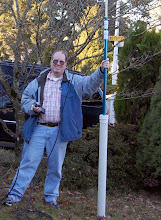
A friend loaned me his SuperAntennas MP1 portable vertical to try out. My week did not go quite as planned (do they ever?), so it was Saturday before I gave it a try. My friend also loaned me a 35 amp-hour battery pack. I recently rehung my G5RV antenna across the house, so thought I would try both antennas during the IOTA contest on battery power.
I toted the battery, radio, antenna switch, coax, and the MP1 to the picnic table and started setting up my station. First, I attached more coax between the G5RV and the antenna switch. Then I connected the antenna switch to the radio with a short piece of coax. For the power, Anderson PowerPoles sure make painless and quick connections. A satisfying "click" and then atmospheric noise indicated the battery had juice and the radio detected same.
Then I read the one page instruction for the MP1. The instructions are adequate for the antenna. I screwed the two rods to the base, attached the whip to the tuning coil, then screwed the coil to the rods. I set the base edge under the battery on the assumption the heavy battery would keep the MP1 vertical, and spread out the four counterpoise radial wires. After I connected the coax, it was ready to test.
I found that the MP1 heard many stations that I could not hear on the G5RV. The G5RV heard more static than the MP1. I heard several loud stations including VC8B on Baker Island in northern Canada (unfortunately he did not hear me), W6AFA in Los Angeles, and a few other stations. No one I called heard me, so Idid not receive any signal reports.
I listened and called for a while, then decided to do other things. After I dismantled the station, I started wondering if the G5RV is still working. That is an open question.
A few things I learned from the short experience:
I toted the battery, radio, antenna switch, coax, and the MP1 to the picnic table and started setting up my station. First, I attached more coax between the G5RV and the antenna switch. Then I connected the antenna switch to the radio with a short piece of coax. For the power, Anderson PowerPoles sure make painless and quick connections. A satisfying "click" and then atmospheric noise indicated the battery had juice and the radio detected same.
Then I read the one page instruction for the MP1. The instructions are adequate for the antenna. I screwed the two rods to the base, attached the whip to the tuning coil, then screwed the coil to the rods. I set the base edge under the battery on the assumption the heavy battery would keep the MP1 vertical, and spread out the four counterpoise radial wires. After I connected the coax, it was ready to test.
I found that the MP1 heard many stations that I could not hear on the G5RV. The G5RV heard more static than the MP1. I heard several loud stations including VC8B on Baker Island in northern Canada (unfortunately he did not hear me), W6AFA in Los Angeles, and a few other stations. No one I called heard me, so Idid not receive any signal reports.
I listened and called for a while, then decided to do other things. After I dismantled the station, I started wondering if the G5RV is still working. That is an open question.
A few things I learned from the short experience:
- Set-up went quickly when the necessary parts are close at hand.
- Battery-powered operation has some benefits, such as no AC power cord and power supply to handle. This allows operation most anywhere so long as the battery has adequate juice.
- The MP1 has potential, as yet unrealized. I think another portable antenna type may meet my operating methods better than the MP1, but I need to try it again.
- Operating outside on a pleasant warm day is much more interesting than operating from my normal shack.




No comments:
Post a Comment